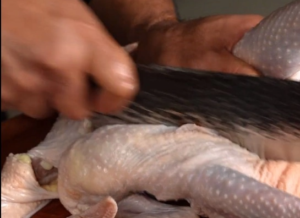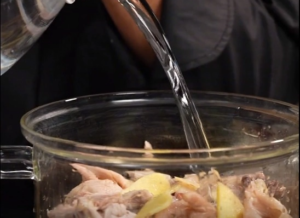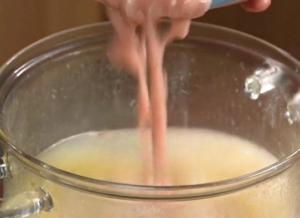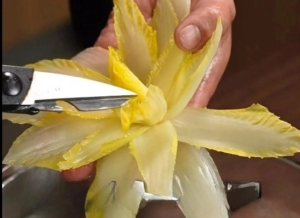
Boiled Cabbage “kai’shui开水白菜“(kāi shuǐ bái cài).
A humble and poetic delicacy, has charmed people with its simple preparation and pure taste. When this refreshing boiled cabbage is placed on the table, it seems as if the whole world becomes serene and pleasant. Boiled Cabbage is made up of tender green cabbage leaves that are washed and blanched in boiling water. The cabbage leaves present a bright color and a clear and translucent texture that brings joy to the heart. Each leaf lightly floats in the transparent boiling water, resembling graceful fairies, emitting a faint fragrance. Taking a bite of boiled cabbage, its crisp texture immediately blossoms in the mouth. The cabbage leaves are tender and delicious, with a slight salty taste that gives a moistening sensation. The juice in the mouth blends with the natural sweetness of the cabbage, making one feel comfortable and content. Each mouthful brings a refreshing flavor, allowing one to experience the blessings of nature.
Comprehensive rating:
| PREP TIME | COOK TIME | VARIETY | MOUTHFEEL | LEVEL |
| 10 min | 480 min | 4 | Rich 、 aromatic | Difficult |
Ingredients for Boiled Cabbage:
| Female chicken | 1000g |
| Green onion | 20g |
| Ginger | 20g |
| Garlic | 10g |
| Chinese cabbage | 100g |
Steps:
1.Choose a fresh chicken: When selecting the chicken, make sure it looks clean, has shiny skin, and no odor or obvious damage. Ensuring good quality chicken is crucial for making delicious dishes. Before handling the chicken, thoroughly wash both the inside and outside. Place the chicken in running water and gently rub the surface to remove any dirt and impurities. Then, carefully remove the internal organs with a sharp knife to ensure cleanliness. Once the chicken is cleaned and the internal organs are removed, you can start deboning the chicken breast. Place the chicken on a cutting board and use a sharp kitchen knife to cut along both sides of the breastbone, gradually separating the meat with your fingers. Be careful during this process to avoid any accidents.

2.Cut the chicken into pieces: Place the cleaned chicken on a cutting board and use a sharp kitchen knife to cut it into chunks, ensuring each piece of chicken is of similar size. Then, prepare a large pot and pour an appropriate amount of water into it. Add some chopped scallions, ginger slices, and garlic cloves to the water, as these seasonings will provide aroma and extra flavor to the chicken. Ignite the heat source and wait for the water to come to a boil. Once the water starts boiling, gently place the cut chicken pieces into the pot. Adjust the heat to low and let the chicken simmer in gentle heat. This process takes about two hours to ensure that the chicken becomes tender and flavorful. During simmering, you can occasionally skim off any foam using a sieve or spoon to keep the chicken broth clear. After two hours of simmering, remove the cooked chicken pieces using a sieve or spoon and carefully pour the chicken broth into another container.

3.Chop and simmer the chicken breast: Cut the deboned chicken breast into chunks and mince it with a knife until it becomes finely ground. Make sure to use a sharp knife and proper cutting technique to achieve uniformly ground and sticky meat. Next, pour the chicken broth into a large pot and gently add the minced chicken breast. Reduce the heat and let the minced chicken breast simmer in the broth at a low temperature. During the simmering process, impurities will be released from the minced chicken forming foam. To maintain the clarity of the chicken broth, gently skim off the foam using a sieve or spoon. This step requires patience and attention to remove as much impurity as possible. Repeat this process and extend the simmering time for at least 6 hours. After skimming off the foam each time, continue simmering on low heat to allow the minced chicken breast to fully blend with the chicken broth and further remove impurities. After 6 hours of slow simmering, the chicken broth will become clear like water without any turbidity or impurities. At this point, turn off the heat, indicating that the chicken broth is ready.

4.Take out the prepared cabbage: Ensure the cabbage is washed and outer leaves are removed, leaving it clean and tidy. Choose cabbage of moderate size with crisp and tender texture for easier handling when carving. Then, use a knife to carve the cabbage into flower-like shapes. With a sharp and slender knife, start cutting from the bottom of the cabbage and gently slice along the edges of the leaves. You can choose different flower patterns according to personal preference and skill, such as butterflies or chrysanthemums. Pay attention to maintaining stable hand movements and a sharp blade to ensure neat and beautiful flower carvings. Once the cabbage is carved, carefully arrange it on a plate. Finally, take out the pre-prepared simmered chicken broth and keep it warm, then gently pour it over the arranged cabbage. Ensure that the chicken broth evenly covers the entire cabbage flower so that the cabbage can absorb the flavor of the broth. A refreshing and elegant dish of boiled cabbage is ready!

Tips:
- Cabbage selection: Choose cabbage with tender and full leaves. The fresher the leaves, the better the texture.
- Soaking in cold water: Place the carved cabbage flowers in cold water for a while to help them open up and present a more beautiful shape.
Boiled cabbage creates a special atmosphere. During the preparation process, we need to invest patience and meticulousness into handling each cabbage leaf to maintain its original fragrance and deliciousness. When enjoying it, it is often chosen to be shared with family or friends, adding to the taste of this simple but artistic dish. Boiled cabbage is a simple and flavorful dish that touches people’s hearts with its pure texture and fresh aroma. Whether prepared at home or tasted in a restaurant, boiled cabbage brings us a sense of tranquility and pleasure. Let’s pause our busy lives, savor this simple and wonderful delicacy, and feel the serenity and satisfaction it contains.

